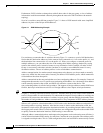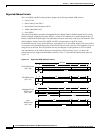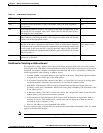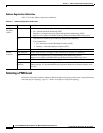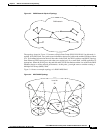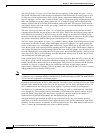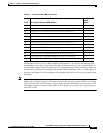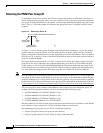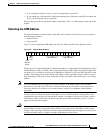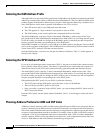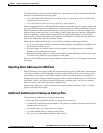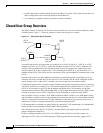
3-8
Cisco PNNI Network Planning Guide for MGX and SES Products, Release 5
Part Number OL-3847-01 Rev. D0, April, 2004
Chapter 3 Address and Closed User Group Planning
Planning Address Configuration Settings
The network shown in Figure 3-4 uses the same physical topology as that shown in Figure 3-3 for an
SPG WAN. The difference is that the physical network has been divided into five peer groups at level
56. The level will be explained later in this section. What is important to understand now is that the
physical topology is still the same as when all nodes were in a single peer group. Dividing the physical
WAN into multiple peer groups simply reduces the size of each peer group, which reduces the total
number of PTSEs and the size of the PNNI database within each node. This improves PNNI network
performance within each of the smaller peer groups, which leaves more bandwidth and node resources
available for processing calls.
The level 40 peer group shown in Figure 3-4 is a logical peer group that has been defined to enable
communications between the peer groups at the lower levels. Each of the level 56 peer groups operate
more efficiently because they do not have to keep up with changes in the other level 56 peer groups.
However, because the level 56 peer groups do not know the details about the other level 56 peer groups,
they cannot communicate with the other groups without help from a higher level process.
The level 40 peer group shown in Figure 3-4 is created by adding a higher-level PNNI processes to one
of the nodes in each level 56 peer group. Each higher level process operates as a logical group node
(LGN) at this higher level, and together these nodes form a logical PNNI peer group at this level. The
level 40 peer group nodes exchange PTSEs regarding the level 56 peer groups and maintain a database
with routing information for communicating between the lower-level peer groups. Level 40 nodes do not
store the routing details stored within the level 56 peer groups, because that information is already stored
at the lower level. The level 40 nodes only store the information that the level 56 nodes need to locate
and communicate with other peer groups.
If the network shown in Figure 3-4 were to grow until there were more than 100 LGNs at level 40, the
level 40 peer group could be divided into multiple peer groups and a higher level could be created to
enable communication between the level 40 peer groups. This process can continue until the practical
maximum of 10 levels is reached. When you consider that 100 level 40 peer groups equate to
approximately 10,000 level 56 nodes (100 level 40 nodes times 100 level 56 nodes), it is easy to see how
adding additional layers enables PNNI to scale.
Note These calculations are based on general guidelines. Peer groups on MGX and SES nodes can support up
to 160 nodes. Also, remember that these calculations are for network nodes, not CPE. The actual number
of CPE and calls supported is considerably higher.
In general, when you create an SPG or MPG network, you need to select a starting level for your PNNI
network, which should be the lowest level you will ever need. You can always add higher levels to an
SPG or MPG network, but creating lower levels requires a significant amount of reconfiguration.
The PNNI level is mathematically related to the ATM addresses used in a PNNI network. Valid levels
are 1 through 104. These numbers specify the number of ATM address bits that are used for the peer
group ID, which is described in the next section. Specifically, the level identifies the number of
sequential most-significant ATM address bits that define the peer group ID.
Although the PNNI specifications provide for up to 104 PNNI levels, they also limit the practical
application to 10 levels. Some PNNI experts suggest that four levels will be sufficient for most PNNI
networks. For these reasons, and because it easier to translate bytes of an ATM address instead of bits,
Table 3-3 shows the recommended levels to use for PNNI networks.





